Radar guidance like infrared (IR) homing guidance is predominantly used in surface-to-air and air-to-air guided weapons. While IR homing guidance is largely employed in short and medium operational ranges, radar guidance is particularly attractive for long-range air-to-air guided missiles. State-of-the-art radar-guided air-to-air missiles using active radar homing guidance technology have operational ranges in excess of 150km. This concluding part of the article focuses on operational aspects of different types of radar-guided weapons. Features and capabilities of major international radar-guided weapon systems are also discussed.
Radar-guided weapons are surface-to-air and air-to-air anti-aircraft-guided missiles in which a radar is used to designate the intended target with electromagnetic energy, and the missiles make use of radar energy reflected from the target to steer itself to intercept and destroy the target. The basic concept is the same as the one used in the case of laser-guided munitions, except for the fact that laser-guided munitions are largely surface-to-surface and air-to-surface weapons and radar-guided weapons are mainly air-to-air and to a limited extent surface-to-air missiles.
Another difference is in their operational ranges, which are much larger in the case of radar-guided missiles, approaching 150km to 200km in the case of state-of-the-art air-to-air missiles than in the case of laser-guided munitions that seldom exceed 20km.

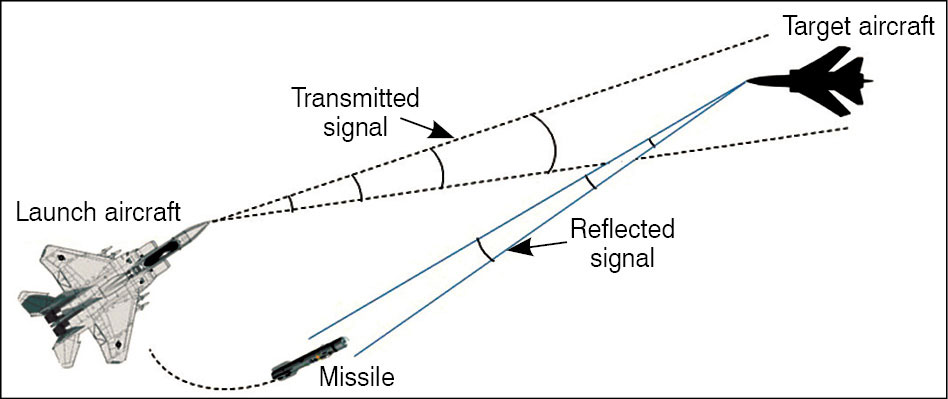
AIM-54 Phoenix and AIM-120D AMRAAM have maximum operational ranges of 190km and 180km, respectively. Also, laser is either on a land based platform or aircraft mounted in semi-active homing guidance. It is an integral part of the weapon hardware in the case of active laser homing.
In the case of radar-guided weapons, the radar is also mounted either on a land vehicle or an aircraft in semi-active radar homing guidance. Radar is an integral part of the guided-missile hardware in the case of active radar homing guidance.
A variation of semi-active radar guidance is track-via-missile (TVM) guidance. Like semi-active homing missiles, the ground based radar designates the target with radar energy, which is then reflected off the target and detected by the radar receiver onboard the missile.
However, unlike a semi-active radar homing missile, the missile does not have hardware and software to compute track and intercept information. Instead, data from the reflected radar energy is relayed back to the ground station via a data link. The ground station computes the track information and communicates it back to the missile.
Radar-beam-riding guidance is another technique that was used in earlier days for short-range surface-to-surface and surface-to-air missiles. But because of inherent shortcomings of the beam-riding concept, both laser and radar beam-riding weapons are more or less an extinct entity.
Semi-active radar guidance
In a semi-active radar guidance system, the target aircraft is illuminated by electromagnetic energy emitted by the fire control radar located either on the launch aircraft or at an appropriate ground location. The fire control radar acquires the target and tracks it. A small radar transmitter generating a very narrow beam then selectively illuminates the target using tracking information generated by the fire control radar. A radar receiver onboard the missile receives the radar energy reflected off the target and locks on to the target.
Once the missile is locked on to target, it may be launched. The radar seeker unit provides the angular error information to the flight path control system, which steers the missile to intercept the target through tail fins.
Semi-active radar homing guidance uses a continuous wave doppler radar in bi-static configuration. It uses bi-static because transmit and receive antennae are at different locations with the former being collocated with a fire control radar either on the launch aircraft or on ground, and the latter on the nose cone of the missile.
Doppler shifted receive signal frequency is computed from the closing velocity determined using flight path geometry. Information on the receive signal frequency is used by the missile to acquire the target. Fig. 1 shows semi-active radar homing basic concept when both fire control radar and missile are onboard the launch aircraft.
Semi-active radar guided weapons have the advantages of being low- cost and less complex. Due to the fact that the fire control radar needs to remain committed throughout the duration of the engagement till the target intercept has been achieved, semi-active radar guidance has certain disadvantages, more so when the radar is located on the launch aircraft. It renders the launch aircraft vulnerable to counter attack from the adversary using anti-radiation missiles as the radar itself acts as a beacon for the counter attacking missile.
Despite this shortcoming, semi-active radar guidance is likely to stay because of better radar resolution and higher power possible with ground based or aircraft-mounted radars.
It may be mentioned here that radar resolution becomes better with an increase in transmit antenna size, and the radar’s size and weight have a direct bearing on power output capability of the radar. A large-size transmit antenna and large-size radar cannot be accommodated within the missile as would be the requirement in active radar guidance.
Raytheon’s AIM-7 Sparrow with an operational range of 30km to 50km for different variants uses semi-active radar homing guidance.
Active radar guidance
In the case of active radar guidance, the missile tracks its target by means of emissions that it generates itself with the radar transceiver located onboard the missile. The missile has the required electronics hardware and software to find and track the target autonomously and does not depend upon the services of an external radar transmitter as is the case in semi-active radar guidance.
Active radar guidance is commonly used for terminal homing in anti-ship, surface-to-air and air-to-air missiles. Fig. 2 shows the basic concept of active radar homing guidance.
One advantage of active radar homing guidance is higher tracking accuracy and better kill probability as compared to semi-active radar guidance. This is due to the missile being much closer to the intended target in the terminal phase than would be the launch platform. This also gives the missile higher resistance to electronic countermeasures.
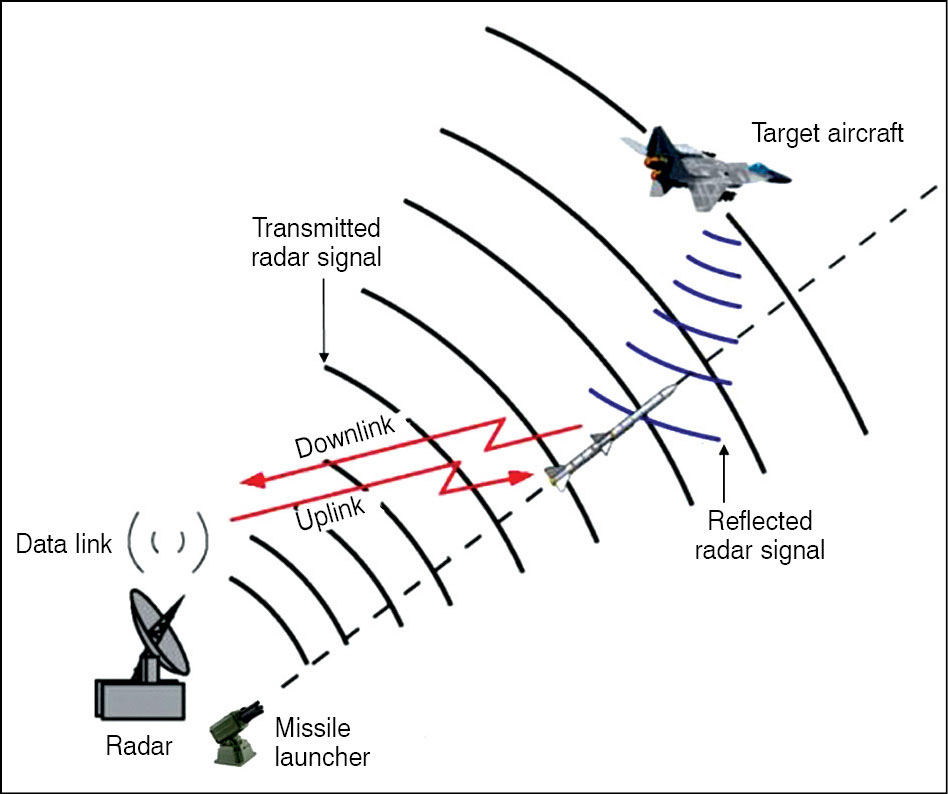
Another major advantage is the much-reduced vulnerability of the launch platform to counter attack. Since the missile is autonomous in the terminal phase, launch platform, ground based or on aircraft need not keep its radar enabled during this phase. In fact, the aircraft in case of being the launch platform can exit the scene or undertake other tasks while the missile homes on to the target providing fire-and-forget capability.
Looking at disadvantages, active radar guided missiles are likely to have increased size and weight as compared to missiles employing semi-active radar guidance. In the case of former, the missile has to accommodate the radar transceiver and electronics for autonomous target tracking.
Also, these missiles are more expensive as sophisticated electronics have only one-time use.
Another shortcoming is that, active radar guided missiles, due to radar emission, are more than likely to be detected by sophisticated radar-warning sensors equipping modern fighter aircraft, enabling these to take an evasive action or deploy countermeasures well in time. Given the fact that even modern aircrafts cannot match the manoeuvrability and agility of state-of-the-art missiles, there is not much an aircraft can do to avoid interception.
Due to restriction on size of the radar transmitter that is linked to power available at radar output and size of transmitting antenna that is linked to beam width, active radar guidance alone cannot provide guidance to long-range missiles. A practical solution can be to use semi-active radar guidance or inertial guidance for midcourse correction and active guidance for terminal homing.
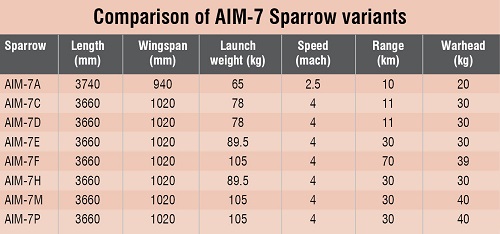
Raytheon’s RIM-174 ERAM, also called standard missile-6 (SM-6), is a state-of-the-art surface-to-air missile in this category, having an operational range of 240km and using a combination of inertial guidance, semi-active radar guidance and active radar homing. It has been in service since 2013.
AIM-54 Phoenix air-to-air missile manufactured by Hughes Aircraft Co. and Raytheon Corp., with an operational range of 190km, also uses a combination of semi-active and active radar homing. It remained in service from 1974 to 2004.
MBDA Exocet anti-ship sea-skimming missile, with an operational range of 70km to 180km, also uses inertial and active radar homing guidance.
Track-via-missile radar guidance
TVM, also called re-transmission guidance, is a combination of semi-active radar homing and radio command guidance. In this case, the target is illuminated by an external radar, and the reflected radar energy is intercepted by a receiver onboard the missile, like it is done in semi-active radar homing.
However, the missile has no onboard computer to process these signals to generate track information. Signals are instead transmitted back to the radar-hosting launch platform over down data link for processing. The missile is then commanded over the up data link to adjust its flight trajectory to intercept the target.
Fig. 3 illustrates the concept of TVM guidance. MIM-104 Patriot missile system is an example of TVM guidance.
Unlike active radar guidance, which alerts the target aircraft about impending danger, in the case of TVM guidance, it may know that it is being illuminated but is never sure whether it is being engaged.
Modern phased-array radars, by virtue of their thin beams and low side-lobe levels, make detection by the aircraft even more difficult. TVM missiles can be made more accurate by using more sophisticated algorithms for calculating interception than would be possible in the limited processor possible to be accommodated in a missile.
In addition, operators have the option of adjusting the missile’s flight path throughout engagement. Radar-hosting ground station may use radar energy reflected from the target directly and combine this information with the downloaded information from the missile to generate the interception course. This improves resistance to electronic countermeasures.
One disadvantage is vulnerability of the ground radar station to anti-radiation missiles as the radar has to remain active throughout engagement.
Possibility of data link jamming is another shortcoming.
Another potential disadvantage is that the missile will not be able to continue engagement if the target aircraft could manage to put an obstacle such as a hillock between the radar beam and itself, or if it could manage to go out of the radar’s tracking envelope.
Missile guidance and control
A missile’s flight path is generally divided into three separate phases, namely, launching or initial phase, mid-course phase and terminal phase.
During the launch phase, flight controls are locked in a neutral position as the missile does not have aerodynamic stability during this phase. The guidance system takes charge immediately after the initial phase is completed and controls are unlocked. The initial phase lasts for a very short duration.
The main task of the mid-course guidance is to place the missile near the target, enabling the terminal phase guidance system to successfully take over. This phase is the longest in both distance travelled by the missile as well as time duration. During this phase, control may need to be exercised to ensure that the missile follows the desired course and also stays on course. In some cases, mid-course guidance may also additionally perform the task of terminal phase guidance.
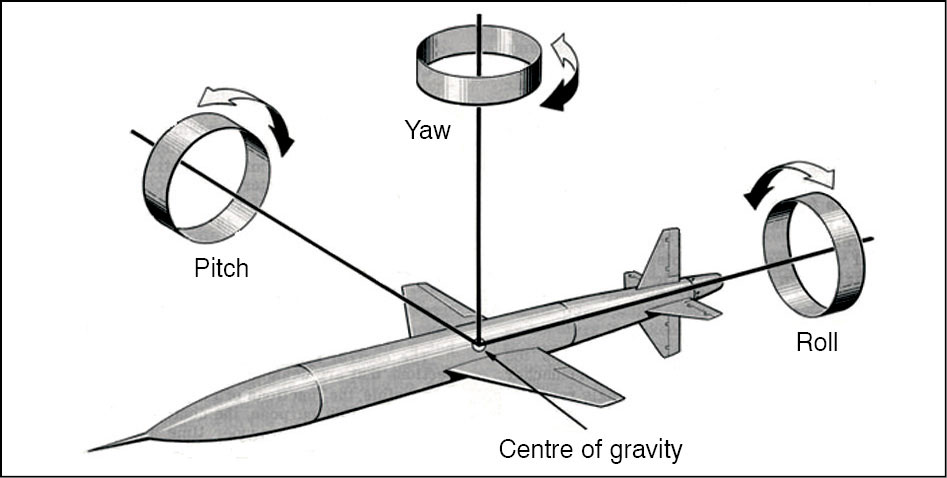
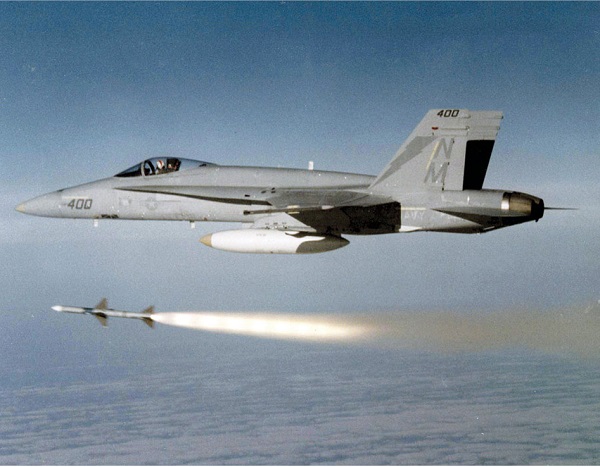
Terminal phase is the most crucial phase of the missile’s flight path, as it is this phase that leads to target-hit or target-miss. The terminal phase guidance system needs to have high accuracy and fast response to guidance signals. Towards the end of the missile’s journey to intercept the target, when the missile is very close to target, it may not be left with sufficient energy to execute any high-g manoeuvre. Proportional guidance helps address this issue.
In the case of radar guidance, semi-active, active or TVM guidance, guidance signal is generated based on radar energy reflected off the target. Every missile-guidance system consists of an attitude control system and a flight path control system.
The attitude control system controls the attitude of the missile in pitch, yaw and roll parameters on the designated flight path (Fig. 4). The flight path control system guides the missile to its designated target. This is achieved by determining flight path errors, generating necessary commands to correct these errors and sending these commands to the missile’s control sub-system that works on servo principle.
Control units make corrective adjustments to missile control surfaces on receiving an error signal. These units also adjust wings or fins to stabilise the missile in roll, pitch and yaw. Guidance and stabilisation are two separate processes that occur concurrently.
Radar-guided missile systems
Now, we will discuss some prominent surface-to-air and air-to-air radar-guided missile systems.
Missile systems described here include AIM-7 Sparrow, MIM-104 Patriot missile system (both semi-active radar-guided missile systems), AIM-54 Phoenix, RIM-174 ERAM, AIM 120D AMRAAM, MBDA Exocet (all active radar-guided missile systems) and Akash surface-to-air missile.
AIM-7 Sparrow is a medium-range, supersonic-speed semi-active radar-guided air-to-air missile manufactured by Raytheon.
A derivative of this missile is the ship based version called RIM-7 Sea Sparrow used for air defence role. The missile had been in active service from 1950’s till 1990’s. It is being gradually phased out in favour of AIM-120 AMRAAM, an all-weather, day/night operation beyond-visual-range air-to-air missile.
AIM-7 Sparrow has a number of variants designated as AIM-7A, AIM-7B, AIM-7C, AIM-7D, AIM-7E, AIM-7F, AIM-7G, AIM-7H, AIM-7M, AIM-7N, AIM-7P and AIM-7R.
Development of AIM-7B, AIM-7N and AIM-7R was discontinued after initial interest. Table I shows a comparison of different variants of AIM-7 Sparrow. Many AIM-7 variants had ship based versions. These included RIM-7E, RIM-7F, RIM-7H, RIM-7M, RIM-7P and RIM-7R. AIM/RIM-7R programme was abandoned in 1996 due to its high costs.
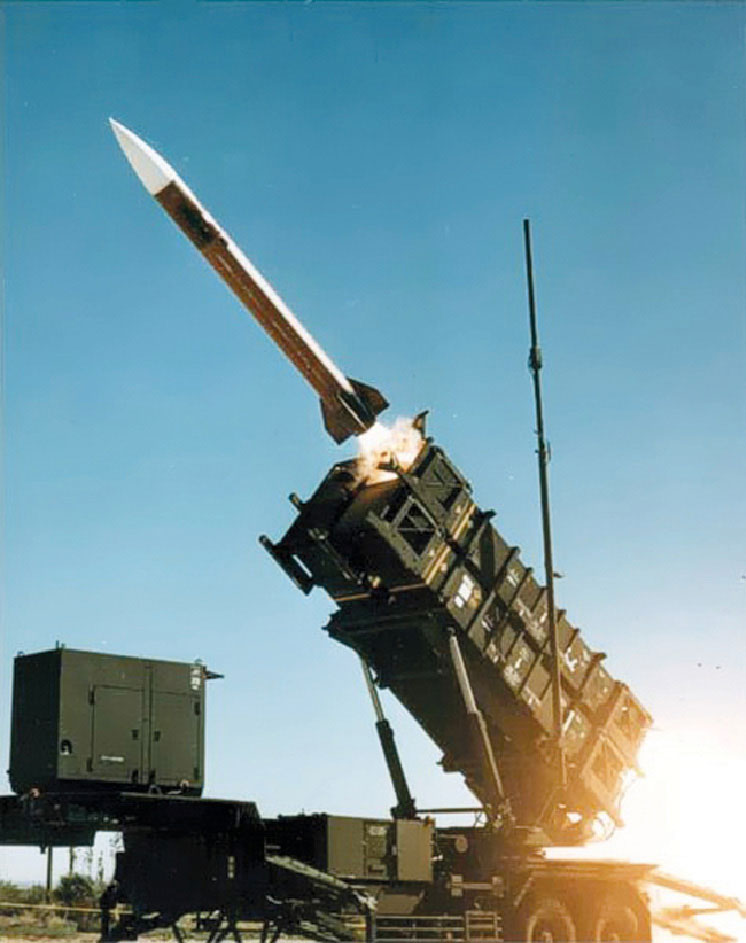
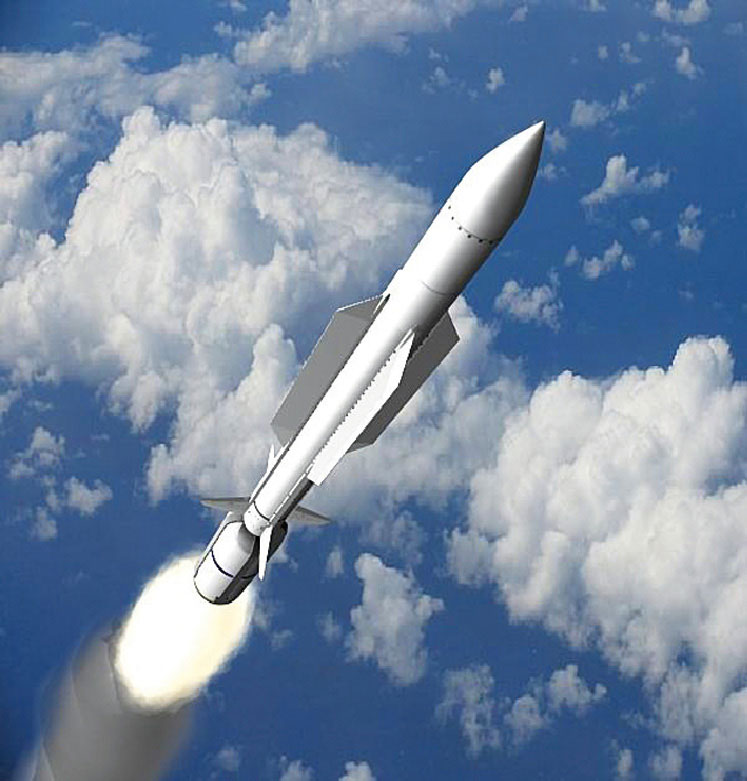
The first operational use of AIM-7 Sparrow was during Vietnamese war in June 1965 when the US Navy shot down two North Vietnamese MiG-17s. Due to the absence of an IFF system on the launch aircraft, long-range capability of these missiles could not be used.
First missiles had a kill probability of only 10 per cent. This problem was subsequently overcome in AIM-7E. The last use of AIM-7 Sparrow was in Operation Desert Storm in 1991, where it was extensively and successfully used on F-15 and F-16 fighter aircrafts. The missile has been on the inventory of armed forces of a large number of countries including Australia, Canada, Israel, Italy, Japan, South Korea, Spain, Taiwan, Turkey, the UK and the USA. Fig. 5 shows AIM-7 Sparrow being launched from F-18A fighter aircraft.
MIM-104 Patriot, manufactured by Raytheon, is a long-range, all-altitude, all-weather air defence system to counter tactical ballistic missiles, cruise missiles and advanced aircraft. The missile system derives its name from the radar component of the missile system.
Patriot stands for phased array tracking radar to intercept on target. It is now given the name anti-ballistic missile (ABM) system, which is its primary mission.
The Patriot system has four major operational functions: communication, command and control, radar surveillance and missile guidance. These functions combine to provide a coordinated, secure, integrated, mobile air defence system.
Patriot missile is equipped with a TVM guidance system. Target is acquired in the terminal phase of the flight by the target acquisition system in the missile. It transmits data using the TVM downlink via the ground radar to the engagement control station for computation of the final course correction. Course correction commands are transmitted to the missile via the missile track command uplink.
The missile has a range of 70km and maximum altitude greater than 24km. Minimum flight time, which is the time to arm the missile, is less than nine seconds, and the maximum flight time is less than 3½ minutes. It is a supersonic missile with maximum speed of Mach 5.
Different variants of Patriot missile system include MIM-104A, MIM-104B (PAC-1), MIM-104C (PAC-2), MIM-104D (PAC-2/GEM), MIM-104F (PAC-3) and Patriot Advanced Affordable Capability-4 (PAAC-4).
The missile system was inducted into service in 1981 and is in service till date. Other than the USA, a large number of other allied nations, including Egypt, Germany, Greece, Israel, Japan, Kuwait, the Netherlands, Saudi Arabia and Taiwan, have this system in their arsenal.
Patriot missile systems were first used during the Gulf War of 1991. There have been controversies about the success rate of the missile system in engaging ballistic missiles during the Gulf War. The system was again deployed in Iraq in 2003 during Operation Iraqi Freedom. The systems were stationed in Kuwait and were reportedly used with success against hostile ballistic missiles.
Recently, during Israel-Gaza conflict of 2014 called Operation Protective Edge, Patriot missile system was successfully used to bring down two unmanned aerial vehicle drones of Hamas. Fig. 6 shows Patriot missile launch.
AIM-54 Phoenix, manufactured by Hughes Aircraft Co. and Raytheon Corp. and capable of attacking more than one aircraft with multiple launches, is a supersonic, radar-guided, long-range air-to-air missile. The missile is carried in clusters of up to six missiles, and while in service during 1974 to 2004, it was used by the US Navy and Air Force of Islamic Republic of Iran.
F-14 Tomcat was the only launch platform capable of carrying AIM-54 Phoenix. The missile system retired from service in 2004 in favour of AIM-120 AMRAAM. This Mach 5 missile has a maximum operational range of 190km and employs a combination of semi-active (mid-course correction) and active radar homing guidance (terminal guidance).
AIM-120 AMRAAM (advanced medium-range air-to-air missile) is a high-supersonic, day/night/all-weather beyond-visual-range (BVR), fire-and-forget air-to-air missile. Manufactured by Hughes from 1991 to 1997 and Raytheon from 1997 till date, it has different variants, which include AIM-120A, AIM-120B, AIM-120C and AIM-120D, with AIM-120D having an operational range in excess of 180km. Operational ranges for other variants are 55km to 75km (AIM-120 A/B) and greater than 105km (AIM-120C).
It employs inertial navigation system (INS) for mid-course guidance and active radar homing for guidance in terminal phase. Once the missile closes to self-homing distance, the active radar guides it towards the target. This feature provides fire-and-forget capability to the missile and allows the pilot to fire a number of missiles simultaneously at multiple targets. Its capabilities include look-down, shoot-down, multiple launches against multiple targets and intercepts at very short range in dogfight situations. It was inducted into service in 1991 and is in service till date with the US Air Force and Navy and more than 25 allies of the USA.
RIM-174 Standard extended-range active-missile (ERAM), also called Standard Missile 6 (SM-6), is a long-range anti-air-warfare missile designed for use by the navy against a range of aerial targets including fixed and rotary wing aircraft, unmanned aerial vehicles, low-attack cruise missiles and anti-ship cruise missiles in flight to provide area and ship defence (Fig. 7).
RIM-174 Standard ERAM meets the need for a vertically-launched, extended-range missile compatible with AEGIS weapon system to be used against extended-range threats.
The missile is also capable of terminal ballistic defence as a supplement to RIM-161 (SM-3). Its design is adapted from RIM-156A (also called SM-2ER), an earlier missile of the Standard missile family. It is a two-stage missile with a booster stage and a second stage.
An addition to the hardware is the active radar homing seeker derived from the seeker used in AIM-120C AMRAAM missile. The active radar seeker gives it the capability to engage highly-agile targets and also targets that are beyond the effective range of the launch vessels’ target illumination radars.
The missile has a maximum operational range of 240km with a maximum cruise speed of greater than 3.5Mach. The system is a combination of inertial guidance, semi-active and active radar homing guidance.
The missile may be employed in a number of modes: inertial-guided to target with terminal acquisition using active radar seeker, semi-active radar homing all the way or an over-the-horizon shot with cooperative engagement capability. The missile was inducted into service in 2013 and is in use by the US Navy, Royal Australian Navy and Republic of Korea Navy.
EXOCET family of missiles, currently manufactured by MBDA, France, are anti-ship, sea-skimming missiles. Different variants of this family have operational ranges of 70km to 180km and can be launched from surface vessels, submarines, helicopters and fixed-wing aircrafts.
EXOCET MM-40 series is the latest in the family of EXOCET missiles, with EXOCET MM-40 Block-3 being the most recent missile in EXOCET MM-40 series. Salient features of EXOCET MM-40 Block-3 missile include effective operational range of 180km, anti-ship as well as littoral operations and land-attack capability, automatic computation of engagement plans to support firing decisions and a sophisticated navigation package comprising hybrid INS/GPS and a radar altimeter and an advanced J-band active radar seeker for terminal guidance.
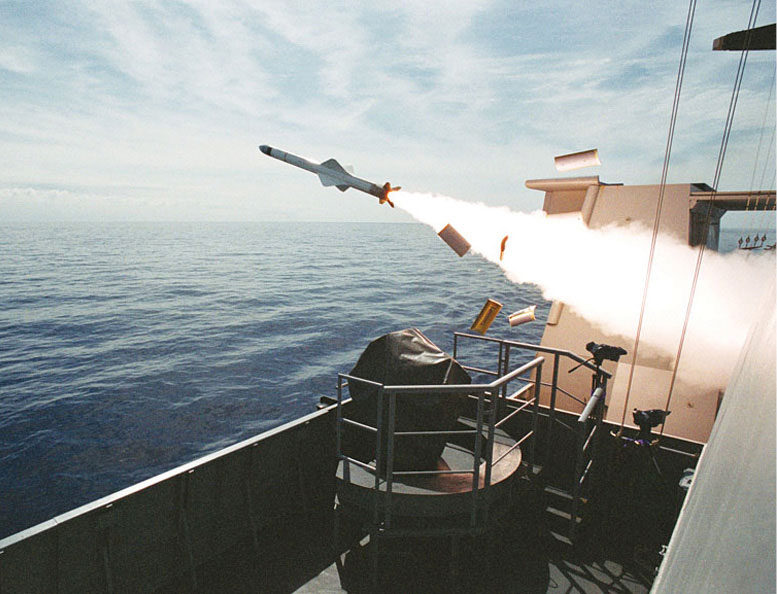
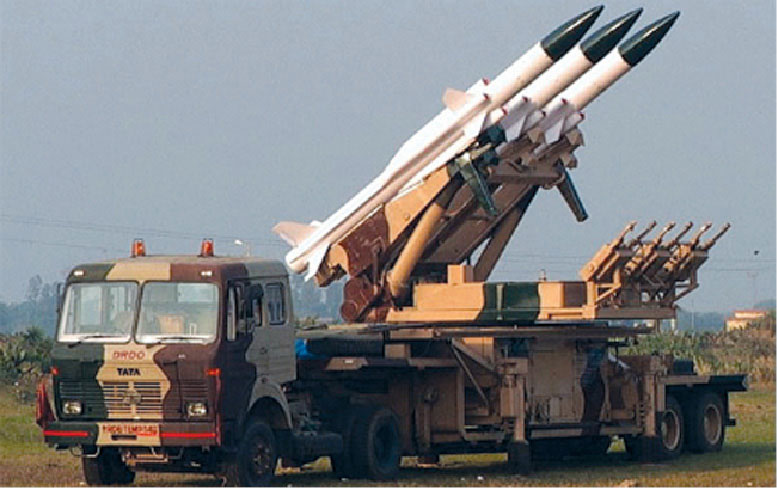
EXOCET missile was inducted in service in 1973, beginning with the air-launched version. It was inducted in the US Navy in 1979. The USA’s Harpoon, Swedish RBS-15 and Chinese Yingji are its main competitors.
It is in use by a large number of countries including India, France, Germany, Greece, Iran, South Africa, South Korea, Pakistan, Indonesia, Turkey and Malaysia. Indian Navy uses it on the scorpene class of submarines.
Akash, developed by India’s state-owned Defence Research and Development Organisation (DRDO) and manufactured by Ordnance Factories Board, Bharat Dynamics and Bharat Electronics, is an all-weather, medium-range surface-to-air missile system with target intercept range of 30k to 35km at altitudes up to 18km.
The missile can be launched from static as well as mobile platforms including wheeled trucks and battle tanks. It is capable of handling multiple targets and destroying manoeuvring targets such as unmanned aerial vehicles, cruise missiles and fighter aircraft. It can carry conventional and nuclear warheads weighing up to 60kg.
The complete system comprises a launcher, missiles, control centre, an integral mission guidance system, multifunctional fire control radar, system arming and explosion mechanism, digital autopilot, C4I (command, control communication and intelligence) centres and supporting ground equipment. Each Akash launcher has three missiles (Fig. 9).The missile was inducted into service in 2009 and is in use by Indian Air Force and Indian Army.
Radar-guided missiles of the future will have enhanced capabilities, particularly in terms of their guidance systems so as to improve kill probability and make these practically a single-shot kill weapon.
One such futuristic missile that will incorporate these features is K-77M from Russia, which aims to frustrate any missile evasion maneuvers enabling a target to escape. The missile would get this feature with a major innovation of K-77M guidance system. The active radar guidance system in the nose of the missile will have its own active phased array antenna (APAA) due to which the missile will have zero reaction time to unexpected manoeuvres of the target aircraft. The missile is expected to be delivered by 2017.






